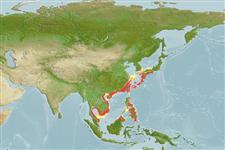Common names from other countries
>
Clupeiformes (Herrings) >
Dorosomatidae (Gizzard shads and sardinellas)
Etymology: Nematalosa: Greek, nema, -atos = filament + Latin, alausa = a fish cited by Ausonius and Latin, halec = pickle, dealing with the Greek word hals = salt; it is also the old Saxon name for shad = "alli" ; 1591 (Ref. 45335).
More on author: Regan.
Environment: milieu / climate zone / depth range / distribution range
Ecología
marino bentopelágico. Tropical; 37°N - 4°N, 98°E - 136°E (Ref. 188)
Western Pacific: Matsushima Bay, Sea of Japan southward to Taiwan Island, Hong Kong, the Philippines, and a single record from Gulf of Thailand.
Tamaño / Peso / Age
Maturity: Lm ? range ? - ? cm
Max length : 19.0 cm SL macho / no sexado; (Ref. 188)
Espinas dorsales (total) : 0; Espinas anales: 0; Radios blandos anales: 17 - 26. Body generally more slender than in other species, belly with total 30 to 34 scutes. Anterior arm of pre-operculum with a fleshy triangle above, not covered by third infra-orbital bone (see N. come). Lower jaw strongly flared outward. Pectoral axillary scale well developed. Hind edge of scales distinctly toothed. A dark spot behind gill opening.
Schooling near shore over sand or mud, preferring warmer water than Konosirus punctatus. A filter-feeder; takes minute algae or organic matter. Breeds around May in Japanese waters.
Life cycle and mating behavior
Maturities | Reproducción | Spawnings | Egg(s) | Fecundities | Larva
Whitehead, P.J.P., 1985. FAO Species Catalogue. Vol. 7. Clupeoid fishes of the world (suborder Clupeoidei). An annotated and illustrated catalogue of the herrings, sardines, pilchards, sprats, shads, anchovies and wolf-herrings. FAO Fish. Synop. 125(7/1):1-303. Rome: FAO. (Ref. 188)
IUCN Red List Status (Ref. 130435)
CITES (Ref. 128078)
Not Evaluated
Threat to humans
Harmless
Human uses
Pesquerías: escaso valor comercial
Herramientas
Special reports
Download XML
Fuentes de Internet
Estimates based on models
Preferred temperature (Ref.
115969): 20.7 - 29, mean 27.4 (based on 340 cells).
Phylogenetic diversity index (Ref.
82804): PD
50 = 0.5005 [Uniqueness, from 0.5 = low to 2.0 = high].
Bayesian length-weight: a=0.00912 (0.00433 - 0.01920), b=3.04 (2.87 - 3.21), in cm Total Length, based on LWR estimates for this (Sub)family-body shape (Ref.
93245).
Nivel trófico (Ref.
69278): 2.4 ±0.16 se; based on food items.
Resiliencia (Ref.
120179): Alto, población duplicada en un tiempo mínimo inferior a 15 meses (Preliminary K or Fecundity.).
Fishing Vulnerability (Ref.
59153): Low vulnerability (13 of 100).
